VOA慢速英语-SCIENCE IN THE NEWS - A Genetic Map for One of the W
时间:2019-01-11 作者:英语课 分类:VOA慢速英语2008年(六)月
Also: A study shows England's Stonehenge was used as a burial ground for 500 years. Transcript 1 of radio broadcast:
16 June 2008
VOICE ONE:
This is SCIENCE IN THE NEWS in VOA Special English. I'm Bob Doughty 2.
VOICE TWO:

A platypus 3
And I'm Barbara Klein. This week, we will tell about a genetic 4 study of one of the world's most unusual animals. We will tell about a health threat to cattle and the people who eat their meat. And, we share findings from a new report about a famous circle of stones in southern England.
(MUSIC)
VOICE ONE:
An international team of researchers says it has completed a genetic map for an unusual-looking animal: the platypus. For years, scientists have been interested in the platypus because it appears to be a mix of several different animals. The platypus has hair covering its body. But it also has a bill surrounding its mouth and webbed feet like a duck.
The researchers sought to understand how this strange creature developed by studying its genome, or full set of chromosomes 5. The new, genetic map shows that the platypus has genes 6 also found in both birds and reptiles 7. The research team reported its findings last month in the publication Nature.
VOICE TWO:
The platypus is native to eastern Australia. The platypus is not endangered; however, people rarely see them. This is because the animals spend much of their time in underground passages along small rivers.
Although the platypus is considered a mammal, it is actually one of two animals known as monotremes. Both the platypus and the echidna are believed to have resulted from other mammals. Scientists believe this separation from more traditional mammals took place more than one hundred sixty million years ago.
The platypus is so unusual that when it was first sent to scientists in Europe in the nineteen century, they thought the animal was a joke.
VOICE ONE:
For the new study, the researchers examined genetic material from a female platypus they call Glennie. She lives in southeastern Australia. A goal of the study was to find which platypus qualities came from ancient reptiles, and which resulted separately in the development of monotremes.
The researchers found that the platypus genome includes some genes not found in other mammals. For example, it includes genes linked to production of eggs. These genes are shared only with reptiles and fish. The platypus also has genetic material for poisonous venom 8 production similar to that of snakes. The venom is found in back legs of male platypuses 9. The animal uses it to attack its enemies or other males.
VOICE TWO:
The platypus also carries mammalian genes for milk production. The animal does not have nipples, like most mammals, to feed its young. Instead, the platypus feeds milk to its young through skin on its abdomen 10.
Among the surprises the research team discovered was genetic material responsible for sensitive odor receptors. Scientists had already known of the platypus' ability to identify electric fields of other animals underwater. The researchers believe the platypus uses the odor smelling ability to find its way underwater, for communication used in mating, or to hunt.
The study also found that the platypus genome is two-thirds the size of the human genome. Eighty-two percent of the animal's genes are shared with mammals.
(MUSIC)
VOICE ONE:
Bovine 11 tuberculosis 12 is a progressive wasting disease. It affects mainly cattle but also sheep, goats, pigs and other animals. People who get bovine TB have to take strong antibiotics 13 for up to nine months to cure them.
People can get sick from infected cows by drinking milk that has not been heated to kill germs. Another risk is eating meat that has not been cooked to seventy-four degrees Celsius 14. If an infected animal is processed, cutting through lung or lymph tissue can spread the M. bovis bacteria to other parts of the meat.
VOICE TWO:
Bovine TB is a major problem in parts of Africa. Farmers in Canada and Britain have also lost many cattle in recent years. In Britain, debate continues about whether badgers 15 pass TB to other animals.
Infected cows might lose weight and develop a cough. The bacteria can spread from the sudden expulsion of air from the lungs. Or infected animals can appear healthy. Then, when they give birth, their milk can pass the infection to their young.
In the early twentieth century, bovine TB probably killed more animals in the United States than all other diseases combined. To control it, the government launched a successful testing program. Historians say animal doctors ordered the destruction of about four million cattle between nineteen seventeen and nineteen forty.
VOICE ONE:
The American state of Michigan has been fighting tuberculosis in cattle. Experts identified wild deer as the source of infection. The neighboring state of Minnesota and the western state of California have also had to deal with TB in cattle and deer.
Cows and wild deer can infect each other -- for example, if they share cattle feed left in fields during winter. Possible solutions might include building fences or leaving smaller amounts of hay.
VOICE TWO:
Experts say the most effective form of control is to destroy cattle herds 16 that have been exposed to bovine tuberculosis. This prevents any chance that infected cows might be moved to another farm.
In April, the United States Department of Agriculture announced the availability of nearly seventeen million dollars in emergency assistance. The Department said the money is meant for programs to fight bovine TB in California, Michigan and Minnesota.
The states are to use the money to destroy cattle herds shown to have tuberculosis. The aid could also be used to study the affected 17 groups and identify the cause of infection.
(MUSIC)
VOICE ONE:

Stonehenge
Finally, new research suggests that England's Stonehenge served as a burial ground for hundreds of years. Stonehenge has long been of interest to archeologists and the public. Thousands of people visit the area each year.
In the past, archaeologists thought that burials at Stonehenge continued for only about one hundred years. Studies had shown human remains 18 were buried there between four thousand six hundred and four thousand seven hundred years ago. That is about a century before the famously large stones were placed there.
VOICE TWO:
Recent tests of human remains show burials instead took place at Stonehenge over a period of about five hundred years. Researchers used radiocarbon dating tests to estimate the age of the remains. The researchers say the burials began there as early as three thousand years B.C., or about five thousand years ago.
The latest burial discovered was identified as a woman in her twenties. Her remains date back to around four thousand five hundred years ago. That is around the same time period when the huge stones, also known as sarsen, were put up.
VOICE ONE:
The latest research marked the first radiocarbon dating of human remains from the Stonehenge area. Scientists believe that as many as two hundred forty people were buried in the area. All of the human remains found there were burned before being buried in the ground.
Mike Parker Pearson is an archaeology 19 professor at the University of Sheffield in England. He is also the head of the Stonehenge Riverside Project. The project is a seven-year archaeological investigation 20 of Stonehenge. The National Geographic 21 Society provided financial aid for the research. The team's findings are published this month in National Geographic magazine.
VOICE TWO:
Professor Parker Pearson says that scientists continue to debate questions like who built Stonehenge and why. He says evidence supports the theory that the area served as a burial ground for a single ruling family. He says thirty to forty generations were buried there. The number of remains grew over time. This suggests one family in which each generation included more family members. Because of this, Mister Parker Pearson believes it was not common people who were buried there. He says the remains are likely those of a royal family or one that ruled over the area.
Still, some scientists have other ideas about what the area was used for. They say that more research is needed.
(MUSIC)
VOICE ONE:
This SCIENCE IN THE NEWS program was written by Jerilyn Watson and Brianna Blake, who also was our producer. I'm Bob Doughty.
VOICE TWO:
And I'm Barbara Klein. Read and listen to our programs at voaspecialenglish.com. Join us again at this time next week for more news about science in Special English on the Voice of America.
- A transcript of the tapes was presented as evidence in court.一份录音带的文字本作为证据被呈交法庭。
- They wouldn't let me have a transcript of the interview.他们拒绝给我一份采访的文字整理稿。
- Most of successful men have the characteristics of contumacy and doughty.绝大多数成功人士都有共同的特质:脾气倔强,性格刚强。
- The doughty old man battled his illness with fierce determination.坚强的老人用巨大毅力与疾病作斗争。
- The platypus spends a great deal of its time looking for food. 鸭嘴兽要用大量的时间去觅食。
- One of the mascots was the platypus.吉祥物之一是鸭嘴兽。
- It's very difficult to treat genetic diseases.遗传性疾病治疗起来很困难。
- Each daughter cell can receive a full complement of the genetic information.每个子细胞可以收到遗传信息的一个完全补偿物。
- Chromosomes also determine the sex of animals. 染色体也决定动物的性别。 来自《简明英汉词典》
- Each of four chromosomes divide longitudinally. 四种染色体的每一种都沿着纵向分裂。 来自《现代汉英综合大词典》
- You have good genes from your parents, so you should live a long time. 你从父母那儿获得优良的基因,所以能够活得很长。 来自《简明英汉词典》
- Differences will help to reveal the functions of the genes. 它们间的差异将会帮助我们揭开基因多种功能。 来自英汉非文学 - 生命科学 - 生物技术的世纪
- Snakes and crocodiles are both reptiles. 蛇和鳄鱼都是爬行动物。 来自《简明英汉词典》
- Birds, reptiles and insects come from eggs. 鸟类、爬虫及昆虫是卵生的。 来自《现代汉英综合大词典》
- The snake injects the venom immediately after biting its prey.毒蛇咬住猎物之后马上注入毒液。
- In fact,some components of the venom may benefit human health.事实上,毒液的某些成分可能有益于人类健康。
- Like humans, platypuses carry an X and a Y chromosome. 鸭嘴兽跟人类一样,也有X和Y染色体。 来自互联网
- How to know to there is ascarid inside abdomen?怎样知道肚子里面有蛔虫?
- He was anxious about an off-and-on pain the abdomen.他因时隐时现的腹痛而焦虑。
- He threw off his pack and went into the rush-grass andand munching,like some bovine creature.他丢开包袱,爬到灯心草丛里,像牛似的大咬大嚼起来。
- He was a gentle,rather bovine man.他是一位文雅而反应迟钝的人。
- People used to go to special health spring to recover from tuberculosis.人们常去温泉疗养胜地治疗肺结核。
- Tuberculosis is a curable disease.肺结核是一种可治愈的病。
- the discovery of antibiotics in the 20th century 20世纪抗生素的发现
- The doctor gave me a prescription for antibiotics. 医生给我开了抗生素。
- The temperature tonight will fall to seven degrees Celsius.今晚气温将下降到七摄氏度。
- The maximum temperature in July may be 36 degrees Celsius.七月份最高温度可能达到36摄氏度。
- Badgers had undermined the foundations of the church. 獾在这座教堂的地基处打了洞。 来自《简明英汉词典》
- And rams ' skins dyed red, and badgers' skins, and shittim wood. 5染红的公羊皮,海狗皮,皂荚木。 来自互联网
- Regularly at daybreak they drive their herds to the pasture. 每天天一亮他们就把牲畜赶到草场上去。
- There we saw herds of cows grazing on the pasture. 我们在那里看到一群群的牛在草地上吃草。
- She showed an affected interest in our subject.她假装对我们的课题感到兴趣。
- His manners are affected.他的态度不自然。
- He ate the remains of food hungrily.他狼吞虎咽地吃剩余的食物。
- The remains of the meal were fed to the dog.残羹剩饭喂狗了。
- She teaches archaeology at the university.她在大学里教考古学。
- He displayed interest in archaeology.他对考古学有兴趣。
- In an investigation,a new fact became known, which told against him.在调查中新发现了一件对他不利的事实。
- He drew the conclusion by building on his own investigation.他根据自己的调查研究作出结论。
- The city's success owes much to its geographic position. 这座城市的成功很大程度上归功于它的地理位置。 来自《简明英汉词典》
- Environmental problems pay no heed to these geographic lines. 环境问题并不理会这些地理界限。 来自英汉非文学 - 环境法 - 环境法